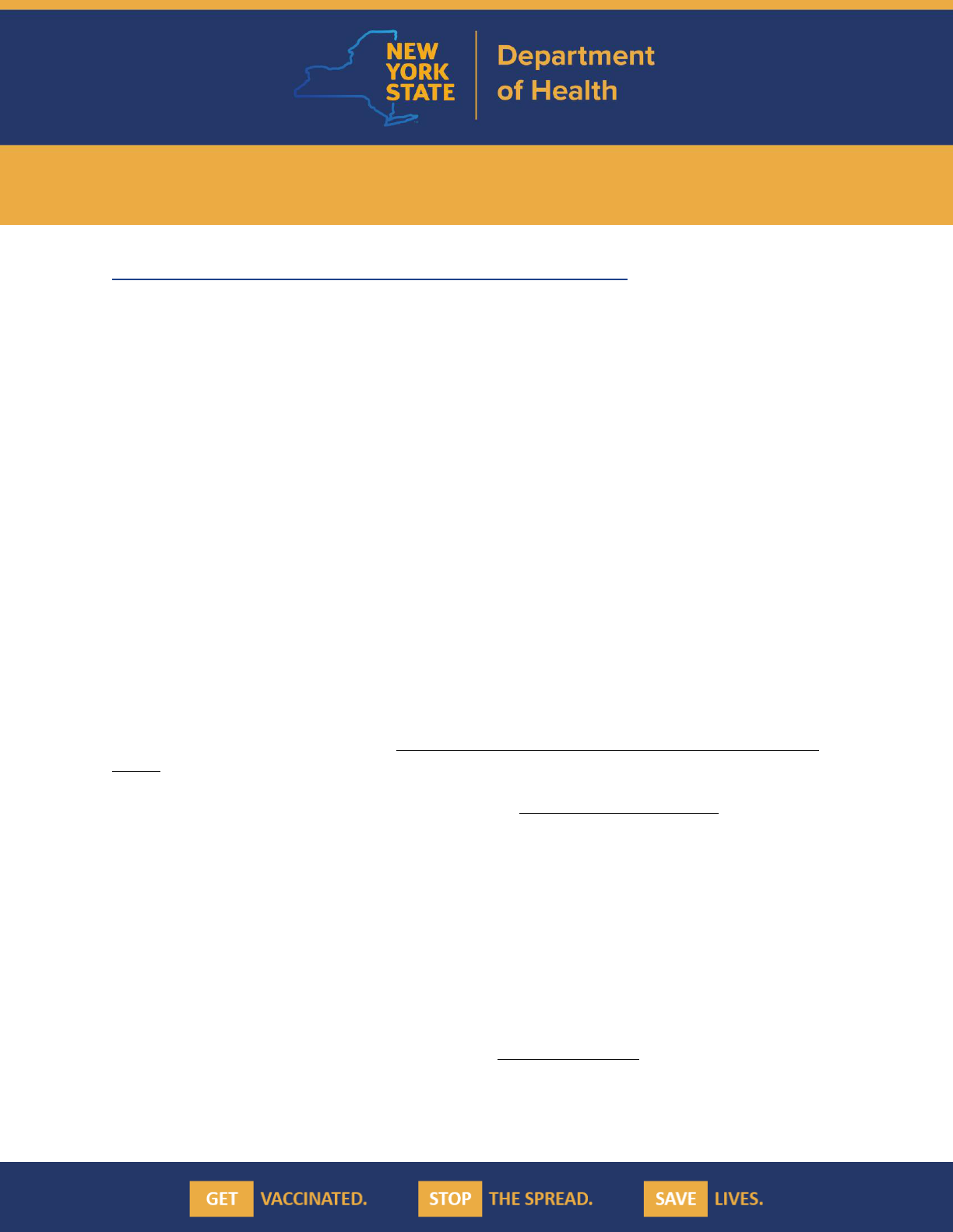
INTERIM GUIDANCE FOR OFFICE-BASED WORK
DURING THE COVID-19 PUBLIC HEALTH EMERGENCY
When you have read this document, you can affirm at the bottom.
As of June 8, 2021
Purpose
This Interim Guidance for Office-Based Work during the COVID-19 Public Health Emergency (“Interim
COVID-19 Guidance for Office-Based Work”) was created to provide businesses and entities that operate
in office spaces and their employees and contractors with precautions to help protect against the spread
of COVID-19 as their businesses reopen or continue to operate.
This guidance addresses business activities where the core function takes place within an office setting.
This guidance may apply – but is not limited – to businesses and entities in the following sectors:
Professional services, nonprofit, technology, administrative support, and higher education
administration (excluding full campus reopening). Please note that these guidelines may also apply to
business operating parts of their business functions under different guidelines (e.g. front office for a
construction company). This guidance does not address medical offices, such as doctors’ offices or
dentists’ offices. This guidance also does not address building owners/managers and their employees or
contractors. For more information on building management, see, “Interim COVID-19 Guidance for
Commercial Building Management.”
Owners and operators of offices are authorized to require masks and six feet of social distancing for
employees within their establishments or adhere to DOH guidance, consistent with the Centers for
Disease Control and Prevention’s (CDC) “Interim Public Health Recommendations for Fully Vaccinated
People.” If choosing to adhere to CDC guidance, offices generally do not congregate patrons or operate
above the State’s social gathering limits, and must follow applicable guidelines for masks, distancing,
and capacity as outlined in New York State’s guidelines on Implementing CDC Guidance.
These guidelines are minimum requirements only and any employer is free to provide additional
precautions or increased restrictions. These guidelines are based on the best-known public health
practices at the time of publication, and the documentation upon which these guidelines are based can
and does change frequently. The Responsible Parties – as defined below – are accountable for adhering
to all local, state and federal requirements relative to office-based work activities. The Responsible
Parties are also accountable for staying current with any updates to these requirements, as well as
incorporating same into any office-based work activities and/or Site Safety Plan.
Background
On March 7, 2020, Governor Andrew M. Cuomo issued Executive Order 202, declaring a state disaster in
response to the COVID-19 public health emergency. Since May 15, 2020, New York State has developed
and deployed a phased economic reopening strategy based on science and data, which has allowed

2
specific industries to safely resume or increase activities and operations while protecting public health
during the COVID-19 pandemic.
In addition to the following standards, Responsible Parties must continue to comply with the guidance
and directives for maintaining clean and safe work environments issued by the New York State
Department of Health (DOH).
Please note that where guidance in this document differs from other guidance documents issued by
New York State, the more recent guidance shall apply.
Standards for Responsible Office-Based Work Activities in New York State
No office-based work activities can operate without meeting the following minimum State standards, as
well as applicable federal requirements, including but not limited to such minimum standards of the
Americans with Disabilities Act (ADA), Centers for Disease Control and Prevention (CDC), Environmental
Protection Agency (EPA), and United States Department of Labor’s Occupational Safety and Health
Administration (OSHA). The State standards apply to all office-based work activities (essential and non-
essential) in operation during the COVID-19 public health emergency until rescinded or amended by the
State.
The State standards contained within this guidance apply to all office-based work activity – both
essential and non-essential – in operation during the COVID-19 public health emergency until rescinded
or amended by the State. The owner/operator of the business with office-based functions, or another
party as may be designated by the owner/operator (in either case, "the Responsible Parties"), shall be
responsible for meeting these standards. The designated party can be an individual or group of
individuals responsible for the operations of individual office locations/spaces. The building owner, or
their designee, shall be primarily responsible for meeting standards with respect to any unleased or
common areas, and the tenant, if not the owner, shall be primarily responsible for meeting these
standards with respect to their leased space(s), unless the tenant and building owner reach an alternate
agreement in regard to such responsibilities (e.g. joint screening protocol). Note that the following
guidance specifically addresses tenants occupying office space and their employees, contractors, and
visitors. Responsible Parties for the entities occupying office spaces should coordinate with building
owners/managers, where applicable, on the implementation of practices in accordance with this
guidance.
Note that, except where noted otherwise, references made to “employees” are to the office-based
businesses/tenants and their employees and/or contractors. Responsible Parties should coordinate with
building managers, where applicable, on the implementation of practices in accordance with this
guidance. For more information on building managers and their employees, see “Interim COVID-19
Guidance for Commercial Building Management.”
The following guidance is organized around three distinct categories: people, places, and processes.

3
I. PEOPLE
A. Physical Distancing
Responsible Parties must ensure that capacity is limited by the space available for employees to
maintain the required social distance as set forth by the State’s guidance, consistent with the CDC’s
guidelines for fully vaccinated individuals.
o Full vaccination status is defined as having completed the COVID-19 vaccination series of an FDA
or DOH authorized vaccine at least 14 days prior to the date of the event
o In accordance with the State’s guidance, Responsible Parties may allow for fully vaccinated
employees to be spaced at full capacity without six feet distancing within either the entire
establishment or a separate, designated part of the establishment, provided that all individuals
are fully vaccinated.
Responsible Parties must abide by the face covering requirements set forth by the State’s guidance,
consistent with the CDC’s guidelines for fully vaccinated individuals.
o Per Executive Order 202.34, as extended, Responsible Parties may deny admittance to
individuals who fail to wear face coverings.
o Any face covering requirement must be applied in a manner consistent with the federal
Americans with Disabilities Act (ADA) and New York State and City Human Rights Laws, as
applicable.
Responsible Parties may accept proof of vaccination status through paper form, digital application,
or the State’s Excelsior Pass, which provides secure, digital proof of vaccination status, as well as
recent negative diagnostic test results.
Responsible Parties should ensure that a distance of at least six feet is maintained between all
employees at all times in locations where vaccination status is unknown or in unvaccinated sections
(e.g., common areas), unless safety or the core activity requires a shorter distance.
Responsible Parties may modify or reconfigure the use and/or restrict the number of workstations,
employee seating areas, and desks, so that employees are at least six feet apart in all directions (e.g.
side-to-side and when facing one another) and are not sharing workstations without cleaning and
disinfection between use. When distancing is not feasible between workstations, Responsible
Parties must provide and require the use of face coverings or physical barriers (e.g. plastic shielding
walls, in lieu of face coverings in areas where they would not affect air flow, heating, cooling or
ventilation).
o If used, physical barriers should be put in place in accordance with OSHA guidelines.
o Physical barrier options may include: strip curtains, cubicle walls, plexiglass or similar materials,
or other impermeable dividers or partitions.
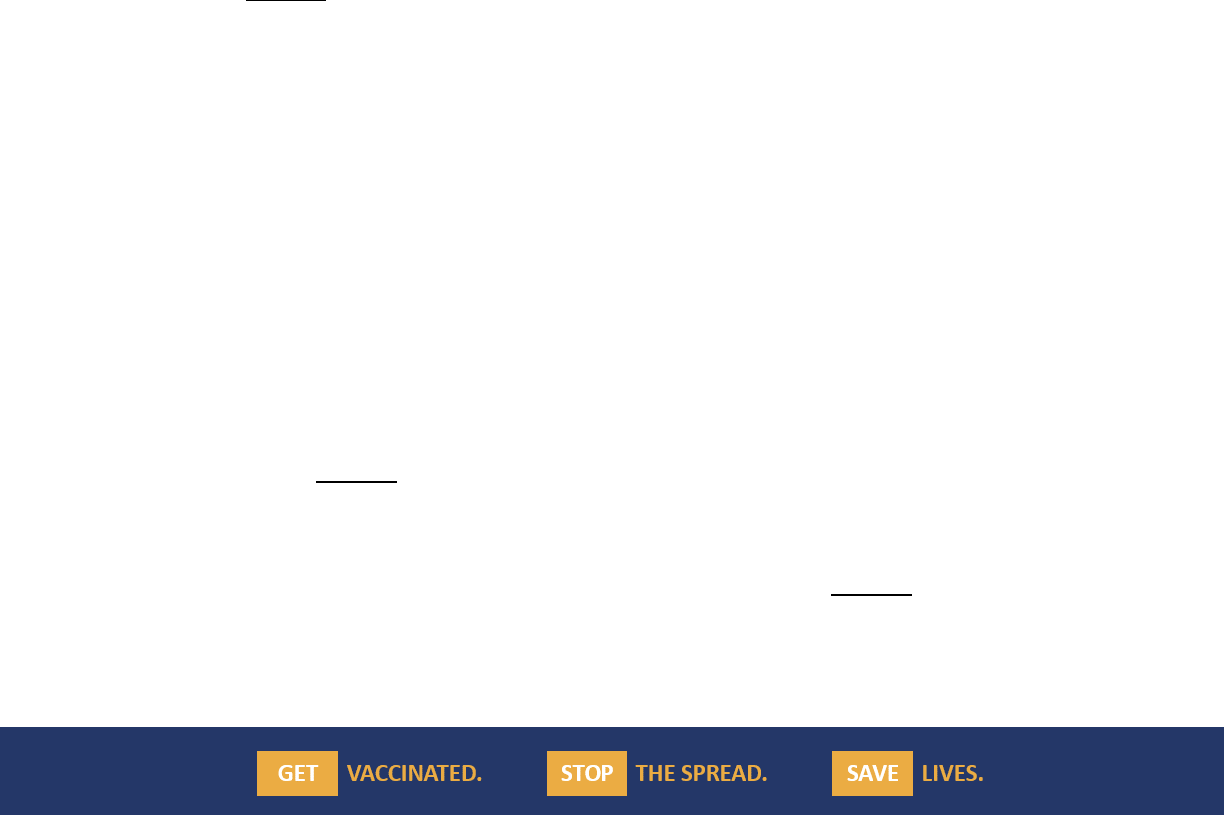
4
Responsible Parties should limit the use of shared workstations (e.g. “hot-desks”), to the extent
practicable. To the extent that such workstations remain in use, they must be cleaned and
disinfected between users.
In the elevators they control and in situations where individuals are unvaccinated or vaccination
status is unclear, Responsible Parties must ensure individuals maintain social distancing and wear
face coverings as set forth by the State’s guidance, unless it is designed for use by a single occupant.
o Businesses may use their discretion to apply these guidelines, e.g.:
▪ Post signage asking unvaccinated individuals to social distance and continue to wear face
coverings
▪ Separate elevators for vaccinated and unvaccinated individuals
▪ Enforce a maximum capacity to maintain the required social distancing for unvaccinated
individuals
o Responsible Parties should take additional measures to prevent congregation in elevator waiting
areas and limit density in elevators, such as enabling the use of stairs.
In other small spaces (e.g., storage or supply closets), Responsible Parties should ensure occupancy
doesn’t exceed the capacity required to maintain social distance, if necessary, as set forth by the
State’s guidance, unless it is designed for use by a single occupant or all individuals are fully
vaccinated.
Responsible Parties should put in place measures to reduce bi-directional foot traffic using tape or
signs with arrows in narrow aisles, hallways, or spaces, and post signage and distance markers
denoting spaces of six feet in all commonly used areas and any areas in which lines are commonly
formed or people may congregate (e.g., copy rooms, kitchens, reception desks, health screening
stations).
o Responsible Parties should mark six feet distance circles around workstations and other
common stationary work areas.
Responsible Parties must post signs throughout the office, consistent with DOH COVID-19 signage.
Responsible Parties can develop their own customized signage specific to their workplace or setting,
provided that such signage is consistent with the Department’s signage. Signage should be used to
remind individuals to:
o Cover their nose and mouth with a face covering when six feet of social distance, as set forth by
the State’s guidance, consistent with the CDC’s guidelines for fully vaccinated individuals.
o Properly store and, when necessary, discard PPE.
o Adhere to physical distancing instructions, as set forth by the State’s guidance, consistent with
the CDC’s guidelines for fully vaccinated individuals.
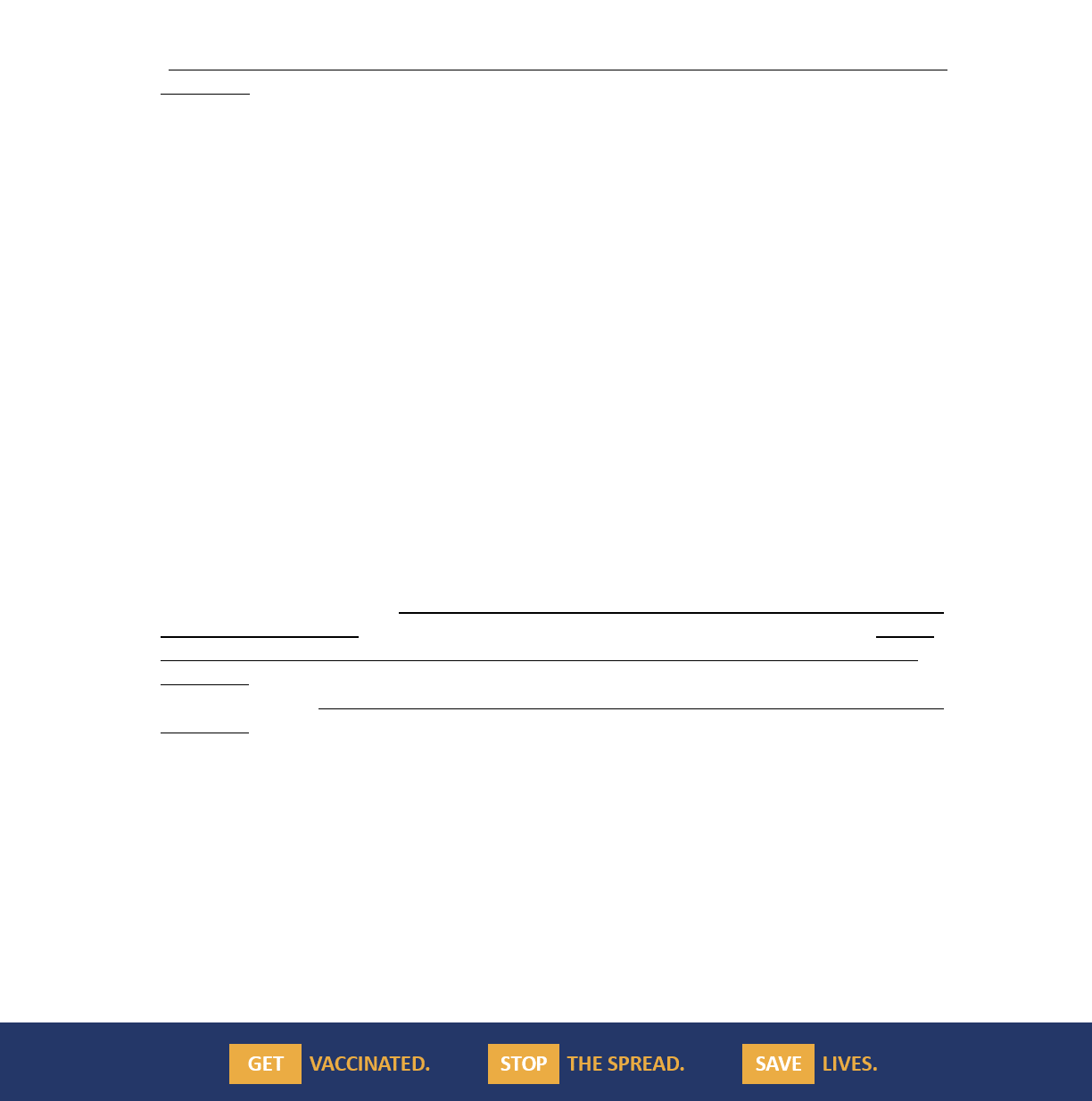
5
o Report symptoms of or exposure to COVID-19, and how they should do so.
o Follow hand hygiene and cleaning and disinfection guidelines.
o Follow appropriate respiratory hygiene and cough etiquette.
B. Gatherings in Enclosed Spaces
Responsible Parties should encourage the use of video or teleconferencing for their employee
meetings whenever possible to reduce the density of in-person gatherings, per CDC guidance
“Interim Guidance for Businesses and Employers to Plan and Respond to Coronavirus Disease 2019
(COVID-19)”. Responsible Parties should hold in-person meetings in open, well-ventilated spaces
and ensure that individuals maintain six feet of social distance between one another (e.g. if there
are chairs, leave space between chairs, have employees sit in alternating chairs) or wear appropriate
face coverings. Responsible Parties may consider implementing the following practices to remind
participants of appropriate social distancing measures when meetings are held:
o Mark tables in meeting rooms with appropriate distance markers.
Responsible Parties should encourage social distancing by limiting occupancy or closing non-
essential amenities and communal areas that do not allow for social distancing protocols. If open,
Responsible Parties must make hand sanitizer or disinfecting wipes available next to equipment near
such amenities (e.g. vending machines, communal coffee stations).
Responsible Parties must put in place practices for adequate social distancing in small areas, such as
restrooms and breakrooms, and should develop signage and systems (e.g. flagging when occupied)
to restrict occupancy when social distancing cannot be maintained in such areas.
Responsible Parties should stagger schedules for employees to observe social distancing for any
gathering (e.g. coffee breaks, meals, and shift starts/stops).
Non-essential common areas (e.g. gyms, pools, game rooms) may reopen in accordance with any
applicable industry-specific guidance. Specifically, gyms and fitness centers must follow the
guidelines outlined in DOH’s “Interim Guidance for Gyms and Fitness Centers during the COVID-19
Public Health Emergency;” pool operations must follow the guidelines outlined in DOH’s “Interim
Guidance for Pools and Recreational Aquatic Spray Grounds During the COVID-19 Public Health
Emergency;” and recreational activities, such as pool and billiards, must follow the guidelines
outlined in DOH’s “Interim Guidance for Sports and Recreation during the COVID-19 Public Health
Emergency.”
C. Workplace Activity
Responsible Parties should take measures to reduce interpersonal contact and congregation,
through methods such as:
o adjusting workplace hours;
o reducing in-office workforce to accommodate social distancing guidelines;

6
o shifting design (e.g. A/B teams, staggered arrival/departure times to reduce congestion in
lobbies and elevators); and/or
o avoiding multiple teams working in one area by staggering scheduled tasks and using signs to
indicate occupied areas.
Responsible Parties may create polices that allow employees to work from home when feasible.
Responsible Parties may choose to develop return-to-office tiers or waves for employees based on
factors such as function, safe transportation, and ability to work remotely.
Responsible Parties may choose to implement best practices for employees to successfully work
from home, such as:
o Conducting regular surveys of employees to determine what practices are working and what can
be improved;
o Providing tips and tricks for employees to enhance remote work sustainability;
o Allowing for employees to set morning and evening boundaries and taking regular breaks
throughout the day;
o Informing employees of the resources they have readily available.
D. Movement and Commerce
Responsible Parties should consider limiting all non-essential travel.
Responsible Parties must establish designated areas for pickups and deliveries, limiting contact to
the extent possible.
Responsible Parties should limit on-site interactions (e.g. designate an egress for employees leaving
their shifts and a separate ingress for employees starting their shifts) and movements (e.g.
employees should remain near their workstations as often as possible).
II. PLACES
A. Protective Equipment
In addition to the necessary PPE as required for certain workplace activities, Responsible Parties
must procure, fashion, or otherwise obtain acceptable face coverings and provide such coverings to
their employees while at work at no cost to the employee. Responsible Parties should have an
adequate supply of face coverings, masks and other required PPE on hand should an employee need
a replacement, or should a visitor be in need. When face coverings are required, acceptable face
coverings include, but are not limited to, clothmasks, surgical masks, and N-95 respirators.
Face coverings must be cleaned or replaced after use and may not be shared. Please consult CDC
guidance for additional information on cloth face coverings and other types of PPE, as well as
instructions on use and cleaning.
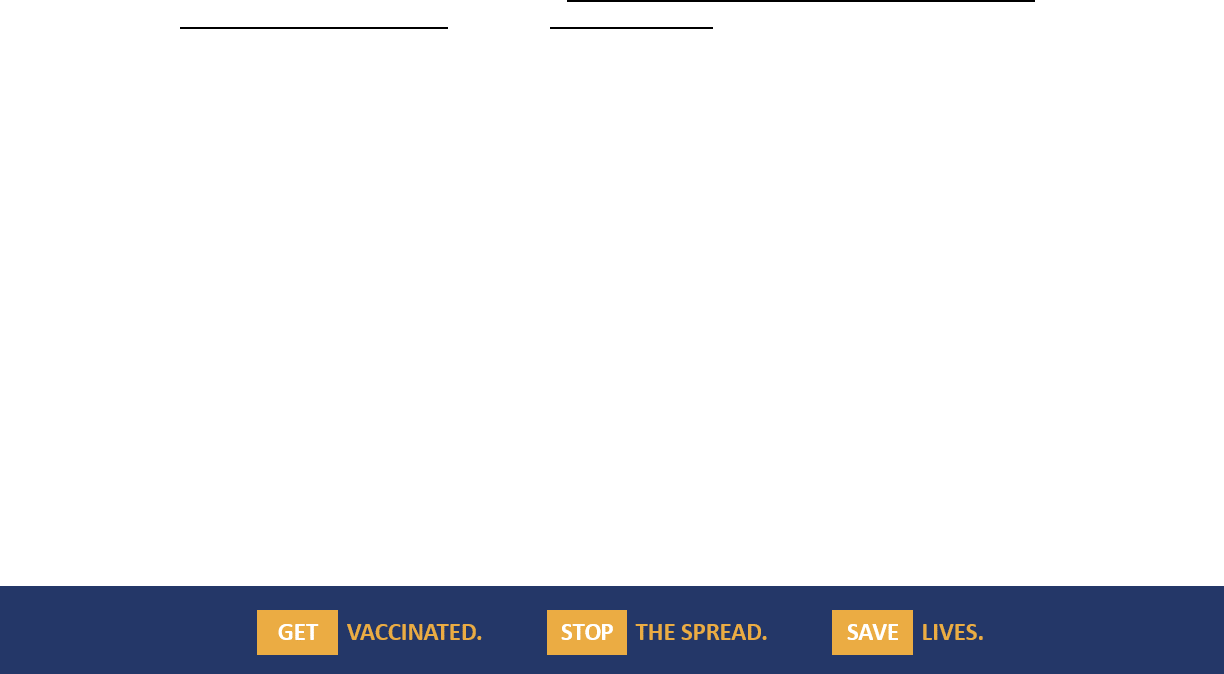
7
o Note that cloth face coverings or disposable masks shall not be considered acceptable face
coverings for workplace activities that require a higher degree of protection for face covering
requirements. For example, if N95 respirators are traditionally required for specific activities, a
cloth or homemade mask would not suffice. Responsible Parties must adhere to OSHA standards
for such safety equipment.
Responsible Parties must allow employees to use their own acceptable face coverings but cannot
require employees to supply their own face coverings. Further, this guidance shall not prevent
employees from wearing their personally owned additional protective coverings (e.g. surgical masks,
N95 respirators, or face shields), or if the Responsible Parties otherwise requires employees to wear
more protective PPE due to the nature of their work. Employers should comply with all applicable
OSHA standards.
Responsible Parties must train employees on how to adequately put on, take off, clean (as
applicable), and discard PPE, including but not limited to, appropriate face coverings. Such training
should be extended to contractors if the Responsible Parties will be supplying the contractors with
PPE.
Responsible Parties must advise employees and visitors to wear face coverings in common areas
including elevators, lobbies, and when traveling around the office.
Responsible Parties must put in place measures to limit the sharing of objects, such as laptops,
notebooks, touchscreens, and writing utensils, as well as the touching of shared surfaces, such as
conference tables; or, require employees to perform hand hygiene before and after contact.
B. Hygiene, Cleaning, and Disinfection
Responsible Parties must ensure adherence to hygiene and cleaning and disinfection requirements
as advised by the CDC and DOH, including “Guidance for Cleaning and Disinfection of Public and
Private Facilities for COVID-19,” and the “STOP THE SPREAD” poster, as applicable. Responsible
Parties must maintain logs that include the date, time, and scope of cleaning and disinfection.
Responsible Parties must provide and maintain hand hygiene stations in the office, as follows:
o For handwashing: soap, running warm water, and disposable paper towels.
o For hand sanitizing: an alcohol-based hand sanitizer containing at least 60% alcohol for areas
where handwashing facilities may not be available or practical.
o Make hand sanitizer available throughout common areas in the office. It should be placed in
convenient locations, such as at entrances, exits, and reception desks. Touch-free hand sanitizer
dispensers should be installed where possible.
Responsible Parties should place signage near hand sanitizer stations indicating that visibly soiled
hands should be washed with soap and water; hand sanitizer is not effective on visibly soiled hands.
Responsible Parties should place receptacles around the building for disposal of soiled items,
including PPE.
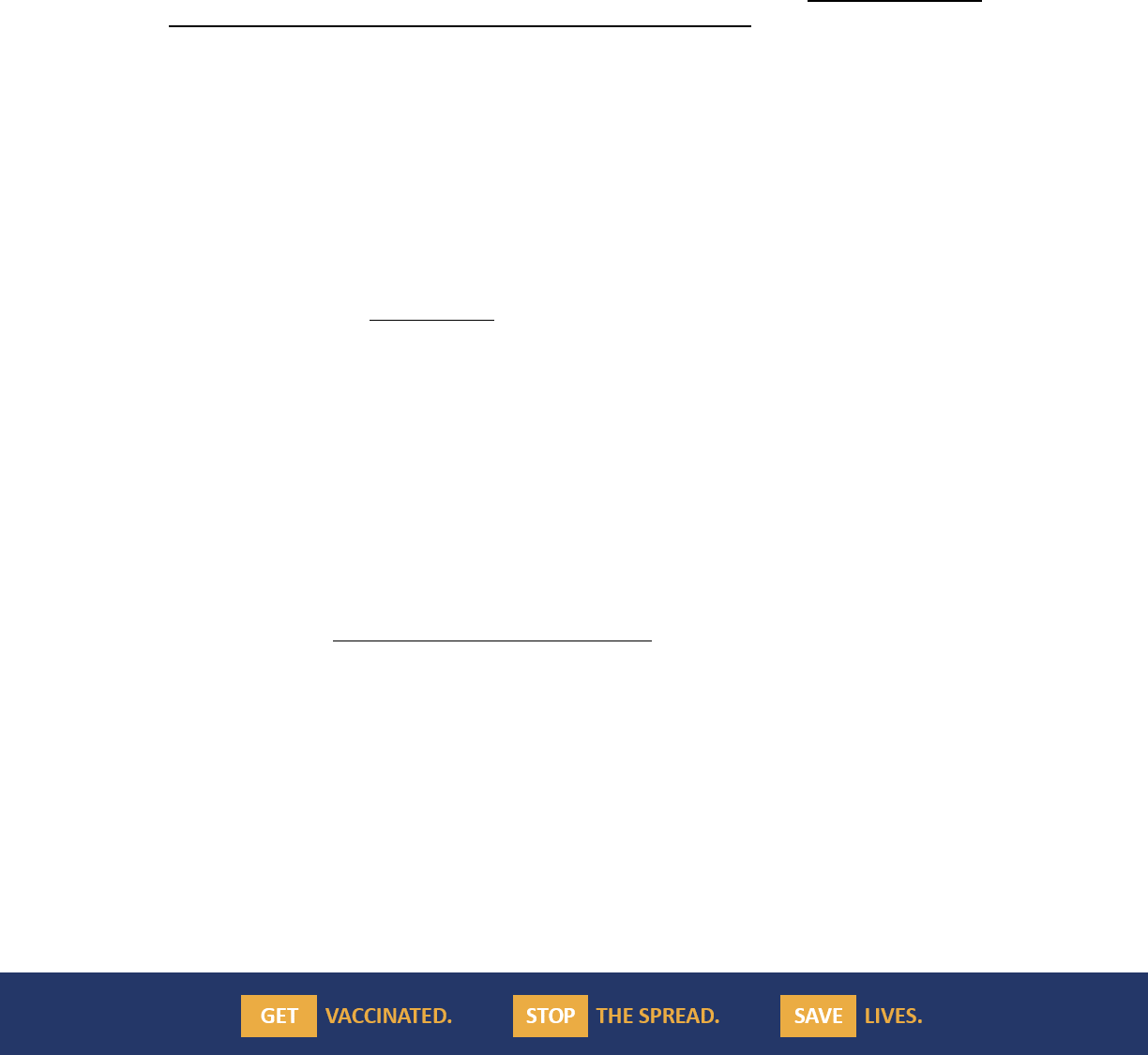
8
Responsible Parties must provide appropriate cleaning and disinfection supplies for shared and
frequently touched surfaces and encourage their employees (or cleaning staffs) to use these
supplies, following manufacturer’s instructions, before and after use of these surfaces, followed by
hand hygiene.
o To reduce high-touch surfaces, Responsible Parties should install touch-free amenities such as
water fountains, trash-cans, and hand-dryers.
Responsible Parties must conduct regular cleaning and disinfection of the building and more
frequent cleaning and disinfection for high risk areas used by many individuals and for frequently
touched surfaces. Cleaning and disinfection must be rigorous and ongoing and should occur at least
after each shift, daily, or more frequently as needed. Please refer to DOH’s “Interim Guidance for
Cleaning and Disinfection of Public and Private Facilities for COVID-19” for detailed instructions on
how to clean and disinfect facilities.
o Responsible Parties must ensure regular cleaning and disinfection of restrooms. Restrooms
should be cleaned and disinfected more often depending on frequency of use.
Responsible Parties must ensure distancing rules are adhered to by using signage, occupied
markers, or other methods to reduce restroom capacity where feasible.
o Responsible Parties must ensure that materials and tools are regularly cleaned and disinfected
using registered disinfectants, including at least as often as employees or visitors change
workstations or move to a new set of materials. Refer to the Department of Environmental
Conservation (DEC) list of products registered in New York State and identified by the EPA as
effective against COVID-19.
o If cleaning or disinfection products or the act of cleaning and disinfection causes safety hazards
or degrades the material or machinery, Responsible Parties must put in place hand hygiene
stations between use and/or supply disposable gloves and/or limitations on the number of
employees using such machinery.
o Responsible Parties must provide for the cleaning and disinfection of exposed areas in the event
an individual is confirmed to have COVID-19, with such cleaning and disinfection to include, at a
minimum, all heavy transit areas and high-touch surfaces (e.g. touchscreens, printers, keypads,
telephones, hand rails, door handles, vending machines, communal coffee stations).
CDC guidelines on “Cleaning and Disinfecting Your Facility” if someone is suspected or confirmed to
have COVID-19 are as follows:
o Close off areas used by the person suspected or confirmed to have COVID-19.
Responsible Parties do not necessarily need to close operations, if they can close off the
affected areas.
Shared building spaces used by the person suspected or confirmed to have COVID-19 (e.g.
elevators, lobbies, building entrances) must also be shut down and cleaned and disinfected
in coordination with the building manager (For more information, see, "Interim COVID-19
Guidance for Commercial Building Management”).
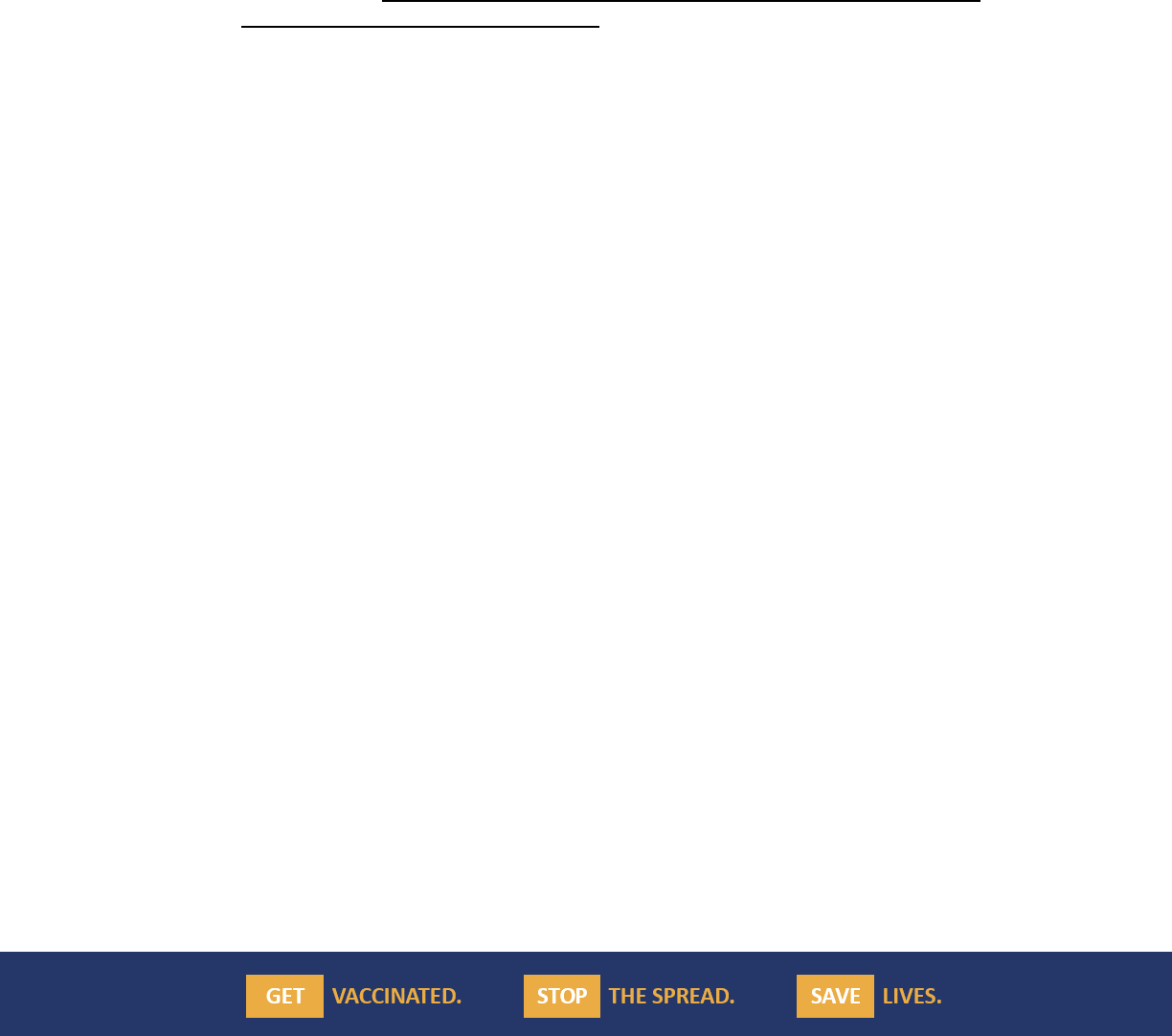
9
o Open outside doors and windows to increase air circulation in the area.
o Wait 24 hours before you clean or and disinfect. If 24 hours is not feasible, wait as long as
possible.
o Clean and disinfect all areas used by the person suspected or confirmed to have COVID-19, such
as offices, bathrooms, common areas, and shared equipment.
o Once the area has been appropriately cleaned and disinfected, it can be reopened for use.
Employees without close or proximate contact with the person suspected or confirmed to
have COVID-19 can return to the work area immediately after cleaning and disinfection.
Refer to DOH’s “Interim Guidance for Public and Private Employees Returning to Work
Following COVID-19 Infection or Exposure“ for information on “close or proximate”
contacts.
o If more than seven days have passed since the person who is suspected or confirmed to have
COVID-19 visited or used the facility, additional cleaning and disinfection is not necessary, but
routine cleaning and disinfection should continue.
Responsible Parties must prohibit shared food and beverages among employees (e.g. self-serve
meals and beverages), encourage employees to bring lunch from home, and reserve adequate space
for employees to observe social distancing while eating meals.
C. Communications Plan
Responsible Parties must affirm that they have reviewed and understand the state-issued industry
guidelines, and that they will implement them.
Responsible Parties should develop a communications plan for employees and visitors, and
customers that includes applicable instructions, training, signage, and a consistent means to provide
employees with information. Responsible Parties should work with building management to help
facilitate any building-wide communications. Responsible Parties may consider developing
webpages, text and email groups, and social media.
Responsible Parties should encourage customers to adhere to CDC and DOH guidance regarding the
use of PPE, specifically face coverings when a social distance of six feet cannot be maintained,
through verbal communication and signage.
Responsible Parties should post signage inside and outside of the retail location to remind personnel
and customers to adhere to proper hygiene, social distancing rules, appropriate use of PPE, and
cleaning and disinfection protocols.
Responsible Parties should provide building managers/owners a list of essential visitors expected to
enter the building.

10
III. PROCESSES
A. Screening and Testing
Responsible Parties must implement health screening for individuals. Health screenings may be
performed via signage, at point of entry, by e-mail/website, by telephone, or by electronic survey
before individuals enter the establishment. Health screenings should include questions on:
o COVID-19 Symptoms: Is currently experiencing, or has recently (within the past 48 hours)
experienced, any symptoms of COVID-19;
▪ CDC advises that COVID-19 symptoms may include fever or chills, cough, shortness of breath
or difficulty breathing, fatigue, muscle or body aches, headache, new loss of taste or smell,
sore throat, congestion or runny nose, nausea or vomiting, or diarrhea; however, a few of
these symptoms may occur with pre-existing medical conditions, such as allergies or
migraines, that have been diagnosed by a health care practitioner. In those cases,
individuals should only answer "yes" if symptoms are new or worsening.
o COVID-19 Contacts: Has had close contact (or proximate contact as determined by health
authorities) in the past 10 days with any person confirmed by diagnostic test, or suspected
based on symptoms, to have COVID-19; and/or
▪ DOH advises that close contact is being within six feet of an individual for 10 minutes or
more within a 24-hour period, starting from 2 days before their symptoms developed or if
asymptomatic, 2 days before they were tested. (Close contact does not include individuals
who work in a health care setting wearing appropriate, required PPE.)
▪ This exclusion shall not apply for individuals who (1) have been fully vaccinated against
COVID-19 with an FDA or DOH authorized COVID-19 vaccine – defined as 14 days after
completion of the vaccine series or (2) fully recovered from a lab-confirmed COVID-19 case
within the past 3 months. (In lieu of quarantine following close contact, such individuals will
need to monitor for COVID-19 symptoms for 14 days following an exposure.)
o COVID-19 Positive Test: Has tested positive for COVID-19 through a diagnostic test in the past
10 days.
Responsible Parties should coordinate with building managers to facilitate screening. Responsible
Parties are responsible for screening their own employees and visitors, unless Responsible Parties
and building management have agreed to an alternate arrangement to ensure screening is in effect.
Screening best practices include:
o If space and building configuration allows, screen individuals at or near the building entrance to
minimize the impact in case of an individual suspected or confirmed to have COVID-19;
o Allow for adequate social distancing while individuals queue for screening and/or building entry;

11
o Coordinate with building managers to identify individuals who have completed a remote
screening;
o Use contactless thermal cameras in building entrances, in coordination with building
management, to identify potentially symptomatic visitors and direct them to a secondary
screening area to complete a follow-on screening.
Refer to CDC guidance on “Symptoms of Coronavirus” for the most up to date information on
symptoms associated with COVID-19.
Responsible Parties must require employees to immediately disclose if and when their responses to
any of the aforementioned questions changes, such as if they begin to experience symptoms,
including during or outside of work hours.
In addition to the screening questionnaire, temperature checks may also be conducted per U.S.
Equal Employment Opportunity Commission or DOH guidelines. Responsible Parties are prohibited
from keeping records of employee health data (e.g. the specific temperature data of an individual),
but are permitted to maintain records that confirm individuals were screened and the result of such
screening (e.g. pass/fail, cleared/not cleared).
Responsible Parties must ensure that any personnel performing screening activities, including
temperature checks, are appropriately protected from exposure to potentially infectious employees
or visitors entering the office. Personnel performing screening activities should be trained by
employer-identified individuals who are familiar with CDC, DOH, and OSHA protocols.
Screeners should be provided and use PPE, including at a minimum, a face mask, and may include
gloves, a gown, and/or a face shield.
An individual who screens positive for COVID-19 symptoms must not be allowed to enter the office
and must be sent home with instructions to contact their healthcare provider for assessment and
testing.
o Responsible Parties should remotely provide such individuals with information on healthcare
and testing resources.
o Responsible Parties must immediately notify the state and local health department about the
case if test results are positive for COVID-19.
Responsible Parties should refer to DOH’s “Interim Guidance for Public and Private Employees
Returning to Work Following COVID-19 Infection or Exposure” regarding protocols and policies for
employees seeking to return to work after a suspected or confirmed case of COVID-19 or after the
employee had close or proximate contact with a person with COVID-19.
Responsible Parties must designate a central point of contact, which may vary by activity, location,
shift or day, responsible for receiving and attesting to having reviewed all employees’
questionnaires, with such contact also identified as the party for employees and visitors to inform if
they later are experiencing COVID-19-related symptoms, as noted on the questionnaire.

12
o If Responsible Parties and building management have agreed to an alternate screening
arrangement whereby building management administers screening on behalf of tenants, then
building management shall be responsible for maintaining a record of the screening process.
Maintaining records of employee health data (e.g. the specific temperature data of an
individual) is prohibited; the only records to be maintained on a daily basis regarding the
screening process are those individuals who were screened and confirmation that no employee
or visitor who failed the screening process was granted access.
Responsible Parties must designate a site safety monitor whose responsibilities include continuous
compliance with all aspects of the site safety plan.
To the extent possible, Responsible Parties should maintain a log of every person, including
employees and visitors, who may have close or proximate contact with other individuals at the
worksite or area; excluding deliveries that are performed with appropriate PPE or through
contactless means. The log should contain contact information, such that all contacts may be
identified, traced and notified in the event an employee is diagnosed with COVID-19. Responsible
Parties must cooperate with state and local health department contact tracing efforts.
B. Tracing and Tracking
Responsible Parties must notify the state and local health department immediately upon being
informed of any positive COVID-19 test result by an employee in their office.
In the case of an employee or visitor testing positive, the Responsible Parties must cooperate with
the state and local health department as required to trace all contacts in the workplace, and the
state and local health department where the building is located must be notified of all individuals
who entered the site dating back 48 hours before the employee or visitor first experienced COVID-
19 symptoms or tested positive, whichever is earlier. Confidentiality must be maintained as required
by federal and state law and regulations.
o As a best practice, Responsible Parties may offer optional tracing and tracking technology (e.g.
Bluetooth enabled mobile applications) to streamline contact tracing and communication
process among their workforce and others.
Responsible Parties must ensure that in the case of an employee showing symptoms while in the
workplace, the building managers are immediately notified with information on where the
individual has been throughout the building and notify building management if the symptomatic
employee tests positive.
State and local health departments will implement monitoring and movement restrictions of
infected or exposed persons including home isolation or quarantine.
Individuals who are alerted that they have come into close or proximate contact with a person with
COVID-19, and have been alerted via tracing, tracking or other mechanism, are required to self-
report to their employer at the time of alert and shall follow the protocol referenced above.
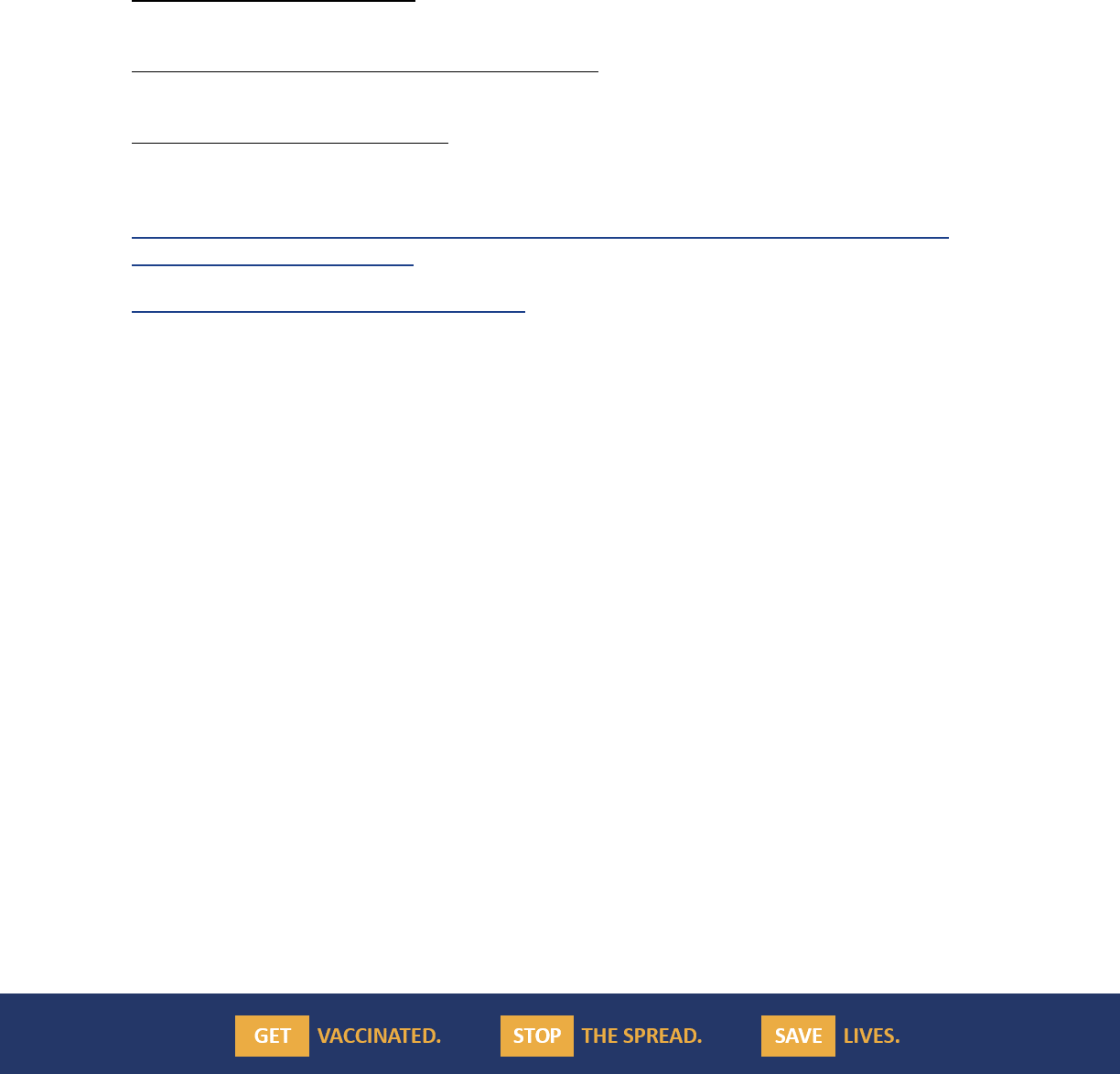
13
IV. EMPLOYER PLANS
Responsible Parties must conspicuously post completed safety plans on site. The State has made
available a business reopening safety plan template to guide business owners and operators in
developing plans to protect against the spread of COVID-19.
Additional safety information, guidelines, and resources are available at:
New York State Department of Health Novel Coronavirus (COVID-19) Website
https://coronavirus.health.ny.gov/
Centers for Disease Control and Prevention Coronavirus (COVID-19) Website
https://www.cdc.gov/coronavirus/2019-ncov/index.html
Occupational Safety and Health Administration COVID-19 Website
https://www.osha.gov/SLTC/covid-19/
At the link below, affirm that you have read and understand your obligation to operate in
accordance with this guidance:
https://forms.ny.gov/s3/ny-forward-affirmation
